
Homeowners in Amsterdam will face a 27 percent increase in property tax next year, the city of Amsterdam said when presenting its . The hike is needed to continue carrying out municipal tasks despite receiving less money from the national government, the city said. Property tax in Amsterdam will increase by an average of 86 euros per home per year, from 313 euros to 399 euros.
“In this way, the municipality can continue to invest unequally in equal opportunities and help vulnerable Amsterdam residents where necessary,” the city said. “We are investing in the city and in the people of Amsterdam, despite the government cutbacks,” Finance alderman Hester van Buren said. “We are investing a lot of extra money in youth care to compensate for shortages from the government, are committed to the energy transition, and are making money available for affordable housing.

” Despite the government cuts to the municipal fund and youth care, the municipality has managed to close the gap in the city budget and set aside money to absorb future financial shocks. The increase in property tax for homeowners plays a big role in that. The city is also implementing cuts on public space, reintegration, and its own organization.
Amsterdam is pushing an extra 25 million euros annually into youth care to make up for the national government’s cuts. “The office does not want people to suffer as a result” of national government policy. It is also releasing 13 million euros for youth care programs that can be used when regular youth care can’t provide a solution.
The city is also pushing money into school swimming so that more kids can be water-safe. It will contribute 3 million euros annually to the Arts Plan until 2027 to make up for national government budget cuts. To ensure that the increasing number of older residents in the city can “grow old healthily and pleasantly,” Amsterdam is investing extra money into caring neighborhoods and accessible gatherings and activities.
The city is also investing more money in shelters and facilities to get people off the streets and increase mental health support. Now that the government has stopped funding the bed-bath-bread shelter for undocumented migrants, extra money will also go toward that shelter. Amsterdam allocated an extra 15 million euros, on top of the 50 million already allocated, to energy transition.
An additional 13 million euros will go toward tackling litter on the streets. €45 million extra is going toward making neighborhoods more pleasant to live in, for example, by improving footpaths and planting more trees. And the city is pushing an additional 10 million euros into enabling the construction of affordable housing by making the process as smooth as possible.
The municipality also reserved 100 million euros because it expects les money from the national government. “The general reserve, which is there to absorb setbacks, is back to full level.” The city’s debt will amount to 6.
9 billion euros at the end of this year and will rise to 8.9 billion euros in 2028 due to investments in the city. The net debt ratio will rise from 54 percent in 2023 to 82 percent in 2028.
“This fits within a responsible debt development and is well below the limit of 110 percent.” The bump in property tax, which may also be passed on to some tenants, is one of several items set to dent the wallets of Amsterdam residents. The city is eliminating nearly all remaining free parking areas within 12 months, having just implemented a substantial increase to parking permit fees, hourly rates, and its P+R lots last year.
Discussions about possible route consolidations and cuts within the city’s GVB public transport network were shelved for the time being but could be implemented by 2026. The chance of this happening could increase if the national government moves ahead with plans to cut 100 million euros in funding to public transport in Amsterdam, Rotterdam and The Hague. Train journeys provided by national railway NS are also likely to be 6 percent more expensive next year.
There are more than 15 passenger rail stations serving the greater Amsterdam area..










